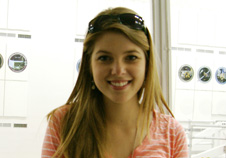Scoping out the changing planet from afar

On co-op with an environmental consulting firm in Vancouver, Canada, called ESSA Technologies, Northeastern University senior Emily Snead tested remote-sensing tools that will be used to pinpoint the impact of climate change on forest life.
The experiential learning opportunity has convinced Snead to pursue a master’s degree in remote sensing. The technology allows researchers to collect geospatial data — including information on soil and vegetation, fault zones and temperature changes over time —using electromagnetic radiation emitted from aircraft or satellites.
“I want to keep working with these remote-sensing tools and hopefully build a career out of it,” said Snead, an environmental science major with a concentration in biology. “I love the idea of being able to manipulate different wavelengths of light to figure out exactly what’s on the ground without having to go to that specific location.”
Her main project involved researching and analyzing remote sensing data to help ESSA assess the effects of forestry and climate change on watersheds with important fisheries in the province of British Columbia. Snead — who said remote-sensing technology could be used in tandem with more costly and time-intensive fieldwork by technicians on the ground — also worked with expert ecologists on a habitat- and migration-monitoring program for the endangered Tailed Frog species.
The co-op in Canada, she said, built on her knowledge of remote-sensing technology.
Last year, Snead completed a co-op with NASA, where she used similar tools to determine the hazards of potential landing sites for the Mars Rover. At Northeastern, she took an introductory course in geographic information systems.
Today, all of these experiences have combined to expose her to a promising field with vast potential, from exploring Earth’s natural resources to climate-change mitigation.
“It’s an interesting field because you can do so much with it,” said Snead. “I like the flexibility, and it’s a very efficient way to monitor things and to keep tabs on what the earth has and what the earth might have.”





